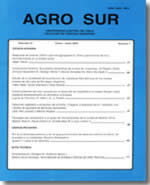Characterization of the growing sites of six native and naturalized pasture species in the Dominio Húmedo of Chile
Main Article Content
Abstract
A large percentage of the grasslands of the Dominio Húmedo of Chile is comprised of native and naturalized species. The presence and abundance of a species in the field is the result of competition and the process of adaptation to the environment. One of the ecosystemic elements which exerts selection pressure on all of the species in the grassland is the soil, Therefore, the effect of the soil on the species can modify the prairie, and the species that adapt best can dominate. The objectives of the study were to characterize the sites where the species that were studied dominated to determine the edaphic factors that produced this selection and to verify if the environmental pressure of the soil over the botanical composition resulted in selection of some of the species. The species studied were Bromus valdivianus, Agrostis capillaris, Lotus uliginosus, Holcus lanatus, Anthoxanthum odoratum and Paspalum dasypleurus. The zone studied was between Panguipulli and Puerto Montt. The species studied dominated in the measured sites. The variables measured were slope (%), depth of the soil (m), hydromorphism, texture, water pH (1:2.5), organic matter (%), mineral nitrogen (ppm N-NO3), available phosphorus (ppm-Olsen), exchangeable potassium (ppm), exchangeable sodium (meq/ 100 g.s.), exchangeable calcium (meq/100 g.s.), exchangeable magnesium (meq/100 g.s.), exchangeable bases (meq/100 g.s.), exchangeable aluminum (meq/100 g.s.), aluminum saturation (%) and species presence (%). A cluster statistical analysis was used to analize the data. Bromus valdivianus dominated sites with well drained, medium textured, deep soils and adequate levels of fertility. Agrostis capillaris was the main species in flat to undulating sites with soils of medium depth, heavy texture, slow drainage, high levels of exchangeable aluminum and high aluminum saturation. Lotus uliginosus dominated depressed sites with narrow soils, light texture, medium to deep permanent hydromorphism and high levels of aluminum saturation and exchangeable aluminum. Holcus lanatus was the principal species in flat to slightly depressed sites with medium texture, medium depth and medium contents of aluminum. Anthoxanthum odoratum dominated flat to undulated sites with high levels of aluminum saturation and exchangeable aluminum. Paspalum dasypleurus was dominant in depressed sites with medium stationary hydromorphism, medium texture, medium depth of the soil, medium levels of aluminum saturation and medium levels of exchangeable aluminum.

